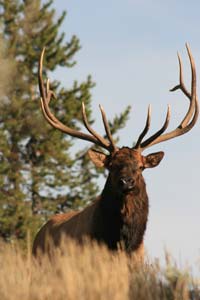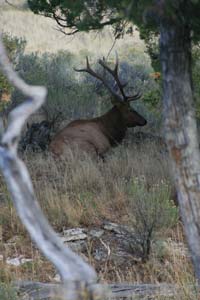
According to the Rocky Mountain Elk Foundation, approximately 1 million elk freely roam in parts of North America. Right behind those elk herds are hunters — hoards of orange-clad hunters who seek to place an elk in their rifle sights and eventually into the frying pan or onto the grill. Elk, however, have the upper hand (or hoof) and many hunters return home with an unused elk tag in their pockets.
 |
| Be careful when moving through the open on your hunt, or an elk could spot you. |
You can improve your odds as an elk hunter. Sometimes the route to punching your elk tag can be as simple as following the numbers. While not required rules, the following ten steps do lead many hunters to an elk hunting success.
No. 1 — Practice often with your rifle, ammunition and hunting gear. It pays to know your shooting limitations, and practical rifle practice can help you increase your accurate range when it's time to send a bullet after an elk. Most shots on elk are taken at, or beyond, 200 yards. The average hunter, however, normally only has access to a 100-yard shooting range. Practice numerous times before going hunting and make the most of your time at the range to improve accuracy.
Pack along shooting sticks or aids to help you be steady and more deadly. While some hunters indicate a preference for shooting off a daypack, lying very flat and low to the ground can cause some hunters to strain to see through the rifle scope. It's often easier to use shooting sticks because they elevate you and the rifle. If you plan to use them, then practice with the sticks at the range.
No. 2 — Know the regional elk. Increase your knowledge through elk hunting videos, books and game department pamphlets. Believe it or not, most states that sell an elk hunting license also have printed materials covering the state's regional elk populations, herd distribution, any recent habitat improvement projects and other details to help you place an "X" on your map. Why waste precious hunting time enrolled in the school of trial-and-error? Study all the information you can about elk, and learn the fine details on the specific elk you'll be hunting. You can also call game department headquarters and biologists to obtain on-the-ground details before you arrive.
No. 3 — Study elk as a species, and understand that elk are not deer. Elk bodies and antlers are bigger than those of a deer, and this tends to make hunters shoot under an elk because they think that the elk is near. Open areas in the West also help with this distorted distance deception. When possible, go to the hunting camp a few days early to help your body and mind adjust to more open spaces and longer distances.
No. 4 — Determine distance. Know the distance to an elk that you spot while afield, and understand your rifle's ballistics at that distance. A rangefinder can help you with the precision distance detection, and the details printed on most ammunition boxes can help you determine bullet drop and impact foot-pounds at that distance. You can also tape a small cheat sheet on your rifle's stock for the ballistics with that caliber and specific bullet. And remember to pack a spare battery for your rangefinder. They seem to always fail in the most remote areas.
No. 5 — Hunt where elk are and not where you wish that they were. Most elk are not standing around in a scenic mountaintop park or low valley hay field during daylight hours, and many elk herds are masters at avoiding all hunters during periods of peak hunting pressure. They're out there, and a map can help you discover where the elk are lurking and bedding. Look for remote draws and the very steep mountainsides that most hunters will avoid Then look for shelves on the terrain. Also, glass into thick timber and sites around avalanches or blow-downs where fallen timber is snarled. On warm days, look for elk on cooler north slopes. Remember, the elk are out there. Answer the question: if you were an elk, where would you go to avoid hunters?
No. 6 — Get in hunting shape. Take hikes, jog or ride a mountain bike off trail with your loaded daypack on. This helps your back, legs and lungs — and helps you become steady for an accurate shot. And when possible, hike and exercise at the altitudes where you plan to hunt. Slight altitude sickness — often signaled by an intense headache — has ruined the hunt for many hunters who never even realize what's happening to them. Remember, also, to drink plenty of water to stay hydrated. The West is an aired place.
 |
| Looking into the shadows and under trees can help you spot a bedded bull elk. |
No. 7— Stay out there. In many camps the normal routine is to hunt a few hours in the morning, return to camp to rest and nap, and then hunt a few hours in before dusk. After spending a large sum of money or investing many hours in traveling to elk camp, it pays to stay afield. Buy a good daypack, load it up with the essentials, and stay away from camp. At the least let other hunters who are returning to camp push elk to you. Elk often move when hunters move, but a big bull is rarely spotted from hunting camp. Keep on hunting!
No. 8 — Glass the world. When hunting, often the best tactic is to pick a vantage point, set up a tripod and begin glassing with a spotting scope or binoculars attached to a base. Look into the timber for antler tips and a leg with a hoof on one end and an elk on the other end. Going up high often lets you peer down into the dense timber below. Take your time and study the page of the world before you much like reading a book. Don't be surprised to see an elk stand and move as the sun begins to shine on its bedding site.
No. 9 — Stay alert. If you hear shots in the distance, be prepared. When another hunter shoots an elk, others in the herd skedaddle, and they could run right toward you. Too many hunters are simply caught off guard or are stunned when elk suddenly appear. And the element of surprise causes many hunters to panic and miss.
Not all elk are in a hurry to move on. If the elk look relaxed, take your time when preparing for and making a shot. Feeding and walking elk move slower than most hunters realize. You often only have one shot opportunity, so relax and make it count.
No. 10 — Be positive. Many hunters become their own worst enemy and doubt that they will see an elk or tag one for the trip home. Negative hunters spend a lot of time looking down at the ground. There are no elk there. Positive hunters keep their chin up and look ahead. Just ahead is where you'll spot that tan and brown form moving through the timber, and you'll be prepared when the bull of your dreams steps out into the open.
Aim carefully, and congratulations!
- 5690 views

